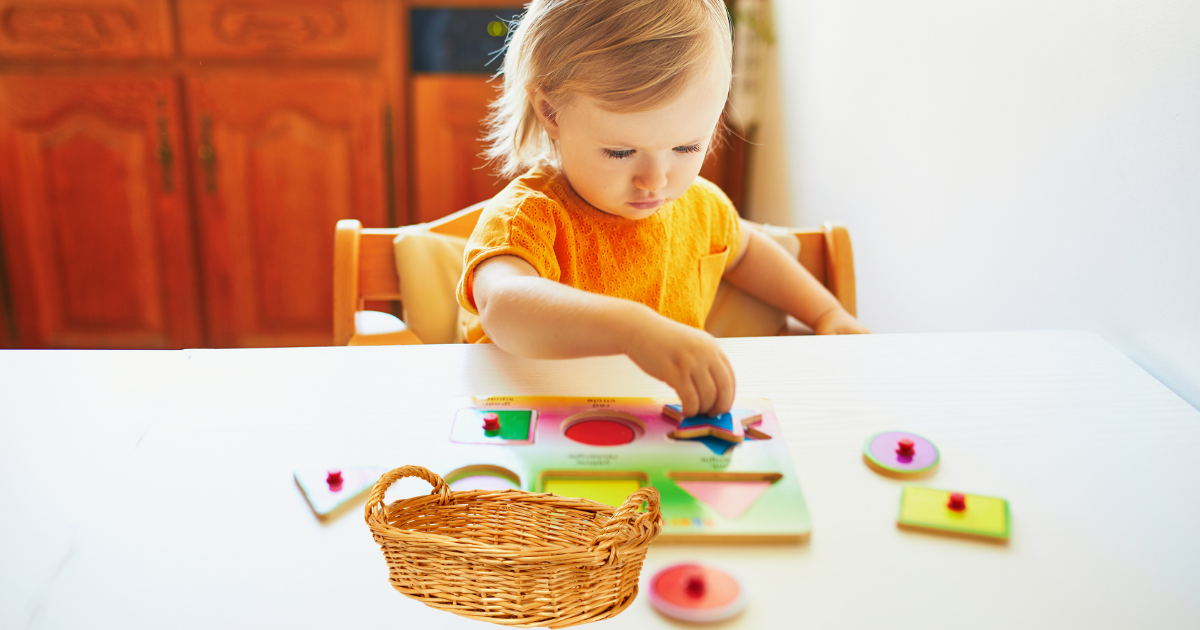Last Updated: October 25, 2024 | Mama’s Shell
Keeping a toddler’s attention for more than a few minutes can feel like an impossible task, but what if their environment could do most of the work for you? Before motherhood, I thought if some toys were laid out in front of a child, they would stay occupied for the rest of the time. Actually, I was building castles in the air. That’s not possible for a toddler at all. Toddlers usually pick up activities based on what seems interesting to them.
So, how do you make an activity interesting for a toddler? How do you keep them occupied?
These are some insights I’ve gained by combining my theoretical knowledge (The Montessori Toddler by Simone Davies, my personal favourite) with my practical experience.
Table of Contents
ToggleUse a Shelf

Don’t shove all of your toddler’s toys into a toy box. Imagine which kind of arrangement would motivate you to study: a bag full of books or a table where all the books and notes are properly organised? Obviously, the second one.
That’s the case for a toddler too. Toddlers are more interested in activities that are organised and age-appropriate for them. Keep all the activities on a shelf that your toddler can easily access. For instance, if you have two kids, you can keep age-appropriate activities for your younger one in the lower section of the shelf and for your older one in the upper section.
Make the Activity Attractive

Some toys, like puzzles, pegs, shape sorters, matching objects with cards, and threading, have lots of small parts. We should place each activity separately in a tray or basket to keep the space tidy and organized. This kind of arrangement makes the activity more appealing to a child. Sometimes my little one doesn’t seem to like an activity very much. In that case, I replace the previous basket with a different vibrant-colored one, and she becomes more interested in working on that activity.
The Montessori method prefers natural elements. Normally, natural materials like woven baskets are used to sort activities. However, I used some cardboard boxes as baskets for my little one. I know it’s not Montessori-aligned, but it worked well for my child. She didn’t put the cardboard in her mouth, nor did she frequently damage the cardboard baskets (though occasionally she damaged one or two baskets, and I immediately replaced them with new ones).
My personal thought is that sourcing all the strict Montessori materials is not a must-do. I source as much as I can without exceeding my budget. The main purpose is to encourage my child’s growth and follow her interests. As long as an object is safe, functional, cost-effective, and encourages skill development, I’m happy to include it in my child’s play.
Prepare and Arrange Each Activity as a Whole

Whenever you prepare a shelf for your toddler, make sure to keep all the related items together. For example, if you keep playdough on the shelf, then along with the container of playdough, also keep molds, cutters, and a mat to protect the table. For matching activities, place all the objects and related matching cards or books in the same tray or compartment of the shelf.
In the case of painting, keep all the necessary items like paints, a pot of water, and brushes in a tray, a basket of fresh papers, an apron hanging on a nearby hook, a mitten ready for spills, an easel, clothespins, and a clothesline to hang and dry their paintings.
Leave Activities Unfinished
To spark your toddler’s interest, leave activities slightly undone. For example, instead of presenting a fully assembled puzzle, place the puzzle base and pieces separately in a tray. This invites your child to complete the activity, making it more engaging.
Organise activities on the shelf from the simplest to the most difficult, moving from left to right. This allows your child to begin with something they can easily complete and gradually move on to more challenging tasks. However, your child may pick an activity from the middle of the shelf too. My little one does this a lot. It’s up to them to choose what to do or not. Arranging activities from left to right will give them a sense of order over time.
Offer Challenging Yet Manageable Activities

If an activity is too difficult, adjust it to match your child’s skill level. For instance, if your child struggles to match a shape puzzle with different shapes, then provide an easier one, like a puzzle with different-sized circles. Offer challenges that are achievable but still promote their development.
Activities that are too challenging and unmanageable will frustrate them. This may cause them to avoid engaging in further activities. But how can we tell when an activity is challenging enough for them without causing frustration? The probable answer is “follow your child.” By observing your child, you will understand their abilities and what level of activity is challenging for them.
Final Thoughts: Be Present
Preparing the environment and setting up activities in an organized way solves 90 percent of your problems. Your child will stay occupied in this playroom setup for a longer period. However, from my experience, my presence is equally important to keep my child engaged in this environment. She seems to have more fun and learn more when I present her with an activity and actively play with her. So, if possible, be actively present during your child’s play and let them lead the way.


